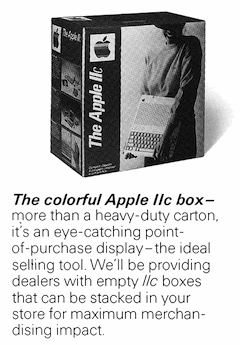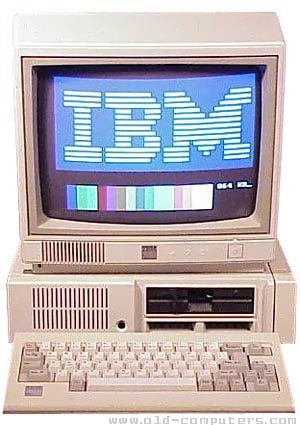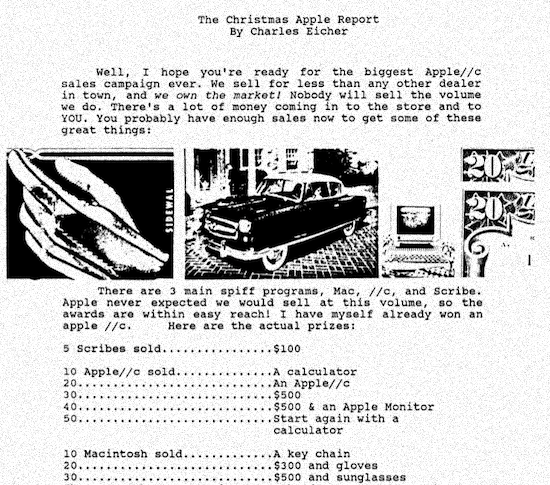Original URL: https://www.theregister.com/2011/11/25/charles_eicher_christmas_1984/
How Apple beat IBM in Steve Jobs' first retail war
A Christmas, PoS tale
Posted in Channel, 25th November 2011 13:00 GMT
The Golden Age of Computer Sales surely must have been Christmas 1984. The Macintosh had just been released, Compaq and IBM offered powerful new CPUs, but the real action was a massive Christmas sales battle between the Apple//c and the IBM PCjr. I remember it well, I was working at ComputerLand in Los Angeles, and I was at the very center of the battle.
The '84 Christmas season would be an inversion of our usual high-end sales efforts. Professional computers from IBM and Compaq were too expensive for the seasonal retail market, and the Macintosh was too new and little software was available. ComputerLand was always intensely busy in December, handling christmas shoppers as well as large corporate customers who had to spend their budgets before December 31. Amidst all this flurry of year-end sales activity, Apple and IBM decided to fight it out in the low end consumer market. The Apple//c was a pretty darn good computer. It was inexpensive, with nice peripherals including a mouse, which had just made its debut on the Macintosh. The //c and the Mac casings were produced by Frog Design, so consumers got some of the cachet of the Mac even if they could only afford a //c.
IBM's competition was a notorious flop, the PCjr. It had just been revamped, the "chiclet" keyboard was replaced with a better model. An inexpensive (but blurry) color monitor was standard. Microsoft produced a "sidecar" with extra memory and its own mouse, and bundled it with primitive apps like PCPaint and PFS:Write. Some of the PCjr's programs came on ROM cartridges since there was only 1 floppy disk drive, with no room for both programs and data. Naturally, the Apple//c outsold the PCjr, by about 10 to 1.
Despite IBM's renewed sales push, the PCjr was dying. It was made specifically with the intention of eroding Apple's lucrative consumer market. IBM desperately wanted to damage Apple by killing their lucrative Apple II cash cow, at a time when investment in the new Macintosh was a heavy drain on Apple's financial resources (and let's not even mention the Lisa debacle).

Apple marketing material
Apple did one really brilliant thing. They worked with Frog Design and their ad agency Chiat Day to produce a most excellent point-of-sale retail experience, foreshadowing today's Apple Stores. And my store in Studio City was a showpiece. Apple produced glossy 4-color packaging for the //c, which had all the sales information written right on the box. We received dozens of empty boxes and we folded them all up and it looked like we had hundreds of computers on display, it reminded me of Andy Warhol's Brillo box sculptures. Apple claimed that all you had to do to sell the //c was put one of the dummy boxes in the customer's hand, get them to a demo station, or do anything to get them to touch the product, and they'd fall all over themselves to hand you money.
It worked.
Even better for us salesmen, ComputerLand pulled a trick unheard of in the LA computer market: we negotiated a mass purchase deal so our cost for the //c was $100 lower than any other store in town. We sold the //c at a price $1 less than other dealers' wholesale cost, we had a lock on the //c market because our competitors had to sell at a loss to match our prices.
But the ComputerLand salesmen wouldn't go for it, they thought the //c was a huge waste of time. The profit on a //c was only $99 and the sales commission was $8, and nobody wanted to waste time with a sale that would net you $8 when the phone was also ringing off the hook with year-end corporate customers making hundreds of thousands of dollars of year-end purchases. But our store figured out a way to juggle things, and Apple sweetened the deal for the salesmen with "spiffs."
Spiffs are Sales Person Incentive Forms, but there are many backronyms. For every Apple you sold, you filled out a form and got a bonus. Suddenly everyone got interested in the //c. Apple had no idea we could sell so many computers. The top prize was a //c computer plus a cash bonus, Apple expected a few salesmen would reach the goal by late December, but I had already won the top prize twice over by the end of the first week of December. During the busiest store hours, sometimes a dozen customers would be stacked up at the register, listening to us explain the features of the computer as we wrote up the sales receipts as fast as our pens would write. And Apple forced a time-consuming duty on us, we had to get the customers to fill out the warranty forms and give us a copy for our spiffs. Customers were hesitant to fill out the forms if the machines were purchased as gifts, it was a real problem to get them to do it. But we persisted because that was how we got paid.

You really don't want a Macintosh. Or a iic.
You want one of these.
IBM wanted some advice...
Throughout Los Angeles, ComputerLand had a complete stranglehold on Apple//c sales. Some of the other chains switched to pushing the PCjr, and we started to get some inquiries, and even I sold a few despite my best efforts to push the //c. IBM had a spiff program too, and I won a PCjr of my own. My boss knew I had both a //c and a PCjr, so I was designated as the chain's expert on these units. My phone started ringing off the hook with sales inquiries from employees at the 5 other stores. I was working 70 or 80 hours a week with corporate customers and retail sales, and now I got stuck handling //c sales questions for other salesmen in our chain.
This was supposed to be a computer that took very little time or effort to sell, so I decided to write a memo on how to sell the machines, just to get these constant questions off my back.
This document is interesting reading today, for a variety of historical reasons. It shows an early attempt at desktop publishing. The draft pages were printed on my Epson dot matrix printer, which had a bad pin in the print head so the text is barely legible, and it printed so faintly that I always used boldface. Illustrations were Xeroxed from books, then glued in place on the printed page, and the final copies were Xeroxed like a fanzine. It is rather amusing to see what was considered a complex word processing document in 1984. It had italics and indented columns and everything!

Indents, italics ... the works!
IBM heard about our massive Apple//c sales and called up our store's owners to find out how we did it. They wanted to know why the PCjr wasn't selling as well, and how to get a piece of the action. My boss asked me to work with IBM and I said absolutely no way was I going to help IBM, I was selling dozens of Apples and I didn't see how competition from the PCjr was going to make me any more money. My boss made it an order, if I wanted to continue to sell anything in their store, I better help them out. It was already the end of the first week of December, there was nothing IBM could do to catch up in the two remaining weeks before christmas, so I agreed. The owners said they'd come with a guest right at closing time on Friday evening.
The owners arrived at my locked-up empty store at the end of a long work week, and I was introduced to the VP of the IBM Personal Computer Division. There was no doubt I was dealing with the highest levels of IBM, and they took this problem quite seriously. I could only think of one thing to do, I asked the VP to walk in to the store and browse as if he were a customer, and I'd greet him and treat him the way we handled customers, then we'd compare the //c and PCjr sales experiences. I'd just spent all week delivering this sales pitch to hundreds of customers, and now I had a solo command performance in front of the IBM VP in an empty store.
The VP walked in and came up to the first sales kiosk, the PCjr. It was on and operational, but there was nothing on the screen. He stopped and looked at the unit, then moved on to the second, less favorably placed kiosk and looked at the //c, which was running a demo disk. He poked a few buttons, moved the mouse when prompted, as I watched him from a distance. Then I came up and said, "hello, may I help you?" and treated him like a customer. He said he was interested in comparing the two machines, so I gave him my best demos on both the machines.
And I do absolutely killer demos.
How to attract customers and influence people ...
We created a simple word processing document and printed it in mere seconds, using Appleworks. The IBM machine used PFS:Write. At the end of the demos, the VP was baffled. The demos were relatively equivalent, demonstrating the same functions, the computers were fairly evenly matched in cost and features, why wasn't the PCjr selling?
I told the VP that he'd failed to observe one thing. Notice that the PCjr was inactive and had a blank screen when he first approached it, but the //c had a nice demo disk that attracted him to interact with the machine. I explained that we could not leave the PCjr in an operating condition, customers would shoplift the expensive ROM cartridges, so we had to keep them locked up and only demo the machine on demand. But if someone swiped the Apple demo disk, I had an extra disk in the back and I could just make a new copy. I explained how this was the crucial difference, the Apple attracted customers all by itself, but PCjr was an inactive lump of plastic unless we actively demoed it. Apple had a carefully planned retail experience, IBM basically had none.
So the question was posed to me: how does IBM fix this?
I told the VP there was absolutely no way to catch Apple, their campaign had been building for months. I said they desperately needed an interactive demo disk like Apple's, but there was no way they'd be able to write and distribute anything like that before Christmas so they were pretty much screwed. I was completely blunt in my opinion. IBM has huge marketing forces, but they are notoriously slow to get into action. The IBM VP seemed to agree that any new sales effort was too little, too late, but he asked for a copy of Apple's demo disk, so the owner quickly popped it out of the //c and handed it right to him. We wrapped things up, and the VP thanked me for my help and we all went home. It was a Friday night, and time for some rest before the big sales weekend was upon us.
On Monday morning, a courier arrived with a package from IBM, containing new demo disks for the PCjr. I looked at the dates of the files; they were all created from scratch on Saturday or Sunday. It was obvious what happened, the IBM VP had cracked the whip, and a huge group of programmers had labored continuously through the weekend to produce this disk, and shipped copies out to every IBM dealer in the US overnight at huge expense. We ran the demo disk and it was absolutely fantastic.
From that moment forward, the PCjr matched the //c in sales. I had given IBM exactly the information they needed. I didn't think they could respond in time, but they did the impossible. IBM put a huge dent in //c Christmas sales, and that was the only reason the PCjr existed. It had no function except to kill Apple II sales. Still, it was a Pyrrhic victory for IBM, they lost money on the PCjr, but they gladly flushed money down the toilet as long as it kept people from buying Apple computers.
In the end, it was a very successful sales season for everyone, money was moving and we couldn't grab it fast enough, and everyone went home believing they had achieved their goals. It was also the zenith of the 8 bit computer era, and the dawn of mass-market computing.
And 15 years before Apple launched its first retail store, it showed Steve Jobs manic attention to detail. Apple couldn’t control everything in the store, but it could try and make the point-of-sale experience insanely great. And that sold computers. ®